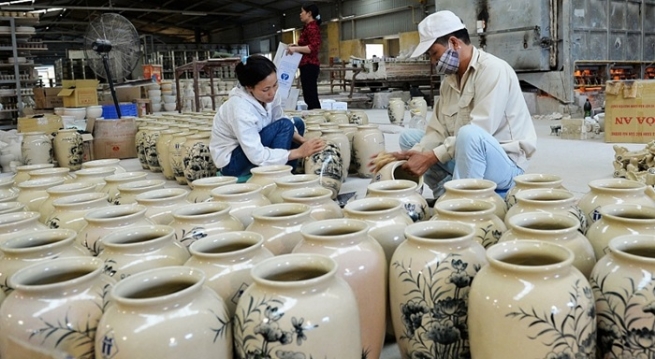Identifying linkage as the foundation of sustainable development, Hanoi has introduced a range of policies to foster craft village growth by renewing production organization models. One main focus is supporting craft villages in creating and promoting collective brands, ensuring product traceability, and strengthening brand storytelling.

Week of introduction of OCOP and craft village products 2025
At the same time, the city is increasing investment in infrastructure for craft village industrial clusters, establishing concentrated production spaces, and ensuring environmental and occupational safety standards. Hanoi also encourages craft villages to join the One Commune One Product (OCOP) program, enabling handicraft products to reach three-star standards or higher and qualify for supermarkets, trade centers, and export markets.
Currently, many skilled artisans in traditional craft villages, instead of producing individually, are joining groups or cooperatives to share premises, machinery, designs, input materials, and product output. “Previously, I only handled small orders for the domestic market. Now, by cooperating with four other workshops, we have formed a linkage group, jointly invested in advanced technology, and hired a sales unit to manage e-commerce platforms. From only serving retail customers, our products are now available in furniture store chains in major cities,” said a representative of a fine wood workshop in a suburban district.
Well-known villages such as Bat Trang Pottery, Van Phuc Silk, and Phu Vinh Bamboo and Rattan are also leading the way in building linkage models with cooperatives, tourism enterprises, and vocational schools. This has created a “linkage circle” between production, trade, training, and cultural preservation, giving strong momentum to craft village products.

Hanoi actively implements support programs for craft village development
A representative of the Hanoi Department of Industry and Trade said that the city is actively implementing support programs for craft villages, from technology application and product design to trade promotion and labor training. The establishment of linkage clusters between craft villages, enterprises, and research-training institutions is seen as essential for modern, efficient, and sustainable development. Many localities have also proposed development and preservation plans, with craft tourism being strongly promoted.
One effective model currently being implemented is the integration of craft villages with experiential tourism. Experts highlighted this as having significant potential to increase local incomes while promoting products and preserving traditional cultural values.
Typical examples include Bat Trang Pottery and Van Phuc Silk, where cooperatives partner with tourism enterprises and training institutions to form linkage circles. As a result, products that were once limited to retail sales now reach nationwide markets and are expanding globally.

In its orientation to 2030, Hanoi has set the goal of developing craft villages within a green and circular economy framework. This requires adopting clean technology, ensuring sustainable environmental treatment, and building closed value chains.
According to the director of a ceramic company, sustainable development depends on long-term policies to support finance and technology transfer for craft villages, especially production models tied to cultural preservation. Enterprises are ready to invest in modern production lines if stable land lease policies and interest rate support are provided.
Many craft villages have already started adopting green design trends, using recycled materials, and focusing on small, customized, high-quality production instead of mass output. Hanoi is also implementing programs to support production, trade promotion, and product consumption, gradually raising the value of craft village products. These efforts encourage artisans and skilled workers to create products of high quality and craftsmanship that meet domestic and international demand.
Experts emphasize that developing craft villages through linkage models is not only an economic solution but also a driver of new rural development. When craft villages grow sustainably, they create local jobs, provide stable incomes, reduce migration pressures, and help preserve traditional cultural spaces.
By Do Ngoc, Vietnam Business Forum
| This special section is supported by Hanoi Coordination Office of the New Rural Development Program |